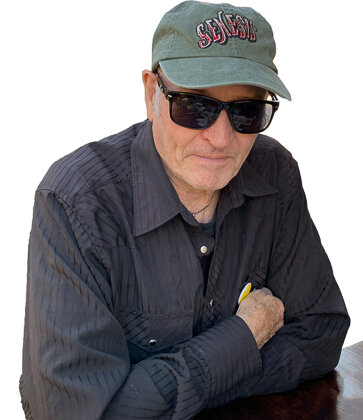
I’d heard about Paul Whitehead from my colleague Michel Plante, who clued me in that Paul is a California-based artist who paints wonderfully complex, spiritual, surrealistic art, who also did the artwork on three Peter Gabriel-era Genesis albums: Trespass, Nursery Cryme, and Foxtrot. Michel thought it’d be a good idea to interview Paul for PMA Media, and I agreed.
I set things up with Paul’s agent, Dan Shapiro, who, at one point while I was mulling over what Genesis questions I could throw at Paul, gave me this advice: “You know, if you could talk to Paul about other things than Genesis that would be great. People keep asking him about Genesis.” “Pffft. Not me,” I sputtered. Then he added: “Did you know he has an alter ego called Trisha Van Cleef? You could talk about her.“
Turned out that Paul has two alter egos and is musical director of sorts of the Borg Symphony, a mostly improvisational collective in terms of music and musicians, the latter “assimilated” members dressed up in Borg attire.
ME: Paul, it’s nice to meet you. Let me start off by saying that I realize you’re weary of answering questions about your work with Genesis, but I am curious about one thing. You did their album covers 50 years ago and more recently their concert poster for their delayed but upcoming reunion The Last Domino? Tour. Are you guys friends? What is the nature of your relationship?
PAUL: Contentious.
ME: Contentious? Really?
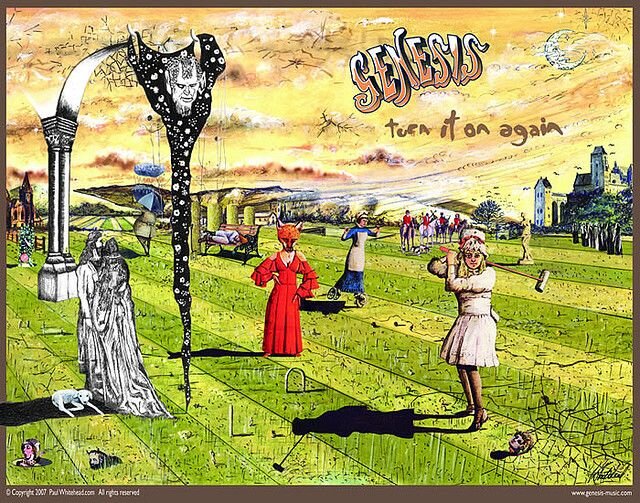
PAUL: Well, it depends. For some reason their manager never liked me. When I did those three records for them, it was only days, right? And it was basically Peter Gabriel and I that collaborated and we did the covers. The other guys in the band really didn’t have much to say in it. And the manager thought the album covers were artsy fartsy. He said they’re too esoteric. And he didn’t believe that record covers sold records. So he’s always labelled me as arsty fartsy.
I’m okay with the band, particularly Peter, we’re great friends, but the other guys, you know… I did a poster and a T-shirt for their 2008 tour (actually, 2007’s Turn It On Again: The Tour – ed.) and my products sold 10 to 1 of theirs and that pissed them off as well (laughs). It’s because people wanted the nostalgia thing.
ME: Is Peter Gabriel the reason you come back to the band?
PAUL: Yeah. Although like you said earlier, that was 50 years ago. It represented 3 years of my life in the 70s. By ’74 I’d emigrated to America.I mean, I don’t have anything bad to say about it.It’s obviously a very good door opener.If I’d been associated with a shitty band, it would be something else. But I’m associated with a good, enduring band. I don’t knock it, but of course, as anybody else, I’ve moved on.
ME: Of course. You do some incredible art work. You’re quite diverse, going so far as to inhabit different personalities. There’s a picture of you on your website dressed in a priest’s uniform with the cross and collar. You call yourself Father Paul. I assume you weren’t ordained by the Catholic Church, so who is Father Paul?

PAUL: Well, the whole thing about religion in America is very different than elsewhere. For $50 you can write to this thing called the Church of… I forget its name, and they ordain you as a minister, right? You get a certificate and you can perform marriages and any religious ceremony that a priest can. And it’s fabulous.
I go to Italy a lot, and so with my friends in Italy I put on the Father Paul act and of course in Italy, it’s like you can do anything, you could commit murder as a priest and get away with it. And you can park anywhere and do whatever the hell you want. And I’m old enough, I look like an old priest, so I totally pull it off. It’s fun. It’s also very weird to see this thing, where you have on this black shirt, and then you put this little strip of white plastic around the collar, and people’s attitude towards you changes. Suddenly, you become this revered figure who is different from everybody else, right? But then I don’t ever make any profanity or degrade being a priest, I act like a priest.
ME: So the idea behind being this priest was about fun?

PAUL: It started off as Halloween one year, right? I found it easy to buy a priest collared shirt. And then someone told me he just became a priest for $50.00. They send you all the instructions. George Clooney‘s a priest by the way. He’s the same church. One of the things about what I do is about people’s perception. I also do a cross dressing character.
ME: Yes, Trisha.
PAUL: I go around the world as a female. To see how people treat you, as a female. It’s totally different than the way people treat you as a guy. So a lot of the stuff I do is about perception.

ME: So it’s part of your art?
PAUL: Yeah, it’s part of my art.
ME: Trisha’s bio on your website mentions that she was initially into fashion design.
PAUL: Yeah. Well, I grew up in the 60s, right? So it was quite natural to wear flamboyant clothes, and feminine sort of clothes. You know, I’d have long hair, shirts with lace and frill on them, jewellery and earrings. My father would freak out but to me it was perfectly normal. So that’s the way I grew up. And I got more into it as I got older. And then one day I had this character and I wondered what kind of art she would make. Would it be different than the art that Paul makes? And it’s very different. My stuff is very contrived and worked out before I even start painting. I do lots of drawings and perspectives, while Trisha’s stuff is totally spontaneous. She never takes more than twenty minutes to do a piece of art. If it takes more than twenty minutes, it’s self-conscious, and I stop. So it’s a very different way of approaching art. One is very cerebral, it’s all about ideas, and the other is just enjoying creating in the moment and seeing what happens. It’s very liberating. And it’s interesting to see the two works in the same gallery. Paul on one side and Trisha on the other, because you’d never think it was the same person.
ME: Do you need to be dressed as Trisha to do her art?
PAUL: No. It’s just a frame of mind. When I exhibit, it’s different. I just had a show in L.A., where I had two adjacent galleries. Paul was in one gallery, and Trisha was in the gallery next door. So I was in the Paul gallery, and then I got changed and went to the gallery next door, right? That was fascinating, because then I started to go backwards and forwards between the two galleries. And I’d see a guy looking at Paul’s work and saying he really like it, and I’d tell him to come with me, and we’d go next door, and he’d say the art there was nice, and I’d say, well that’s me as well. And he’d go whoaaa…

ME: You do a number of art-related things — paintings, word-art, mosaics, music. You also have an arrangement with sculptor Nathan Cartwright to reproduce figurines of some of the characters you created for your Genesis album covers. How did you get involved with figurines?
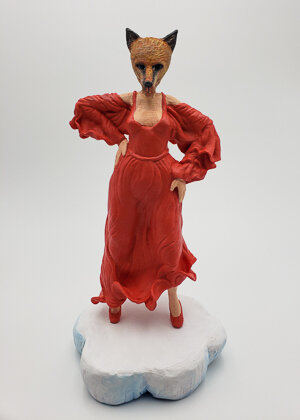
PAUL: Over the years people have asked me about doing action figures. And we looked into it and it was very expensive to do and we had to do large numbers — thousands of them. We didn’t think the market was there. Then about two years ago, my friend said we should try digital printing. You make an original, scan it, and then with the scan you can print it out. So we did the Fox, and it turned out great.
ME: So this was something you always wanted to do?
PAUL: Yeah. It just seemed natural that those characters would be figures, you know?
ME: With all the different art you make, is there one you enjoy making more than the rest? Or is it depending on the week?
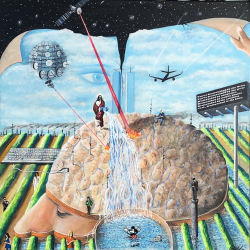
PAUL: (chuckles) Depending on the temperature. (laughs) No, it’s all different head spaces. My regular painting I do is very time consuming and disciplined. You’ve got to sit there for hours. I’m doing less and less of that. I think I’ve done that, you know? I’ve pretty much said all I want to say about that.
Although I just did a painting. There’s a gallery here in L.A. that showed paintings inspired by a song with the lyrics of that song in them. So the guy asked me if I would do one for the show, and the theme of the show was rebellion, and for some reason I came up with the song Brainwashed by George Harrison. It’s the last song he wrote, and it’s a song about how we’re all brainwashed by the media and the government. That’s the last painting I did and I really enjoyed it. And the words of the song are incorporated into the image. I’m interested in doing stuff I haven’t done before.
ME: Do you work every day on your art?
PAUL: I work at something every day. I’m writing a science fiction novel right now. Do you remember a movie called The Day the Earth Stood Still?
ME: The first one?
PAUL: Yeah. Remember the end when Klaatu said to the world “You’ve got to join this club that we’re in, we’re peace-loving planets” and so on, right?”
ME: Umm, what did you think of the 2008 Keanu Reeves remake?
PAUL: It was crap! (deadpan) So then Klaatu gets in his flying saucer and flies away. Well, my story starts in 2038, when he comes back and says “Well, you’ve had time to think about it, you want to join us?” And he gives the world a 12-year ultimatum, until 2050, to get their act together. I’m four years into it already.
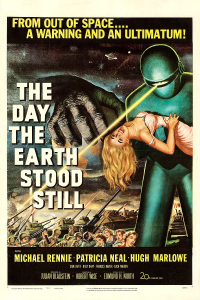
ME: When do you think you’ll complete it?
PAUL: What I’m going to do is finish up until the end of 2042, and that would be a book. Then I’ll write out a synopsis of each year until 2050. I want to present it as a 12-part TV series. The original movie was made by 20th Century Fox, so it might be interesting for them to do it, because it would both renew the interest in a classic science fiction film of theirs and give them a contemporary series.
ME: Will the book contain any of your art?
PAUL: The jacket, yeah.
ME: Just the jacket?
PAUL: Right. (chuckles)
ME: Prog music seems to figure prominently in your creative life, whether it’s to do with your work with Genesis, Van der Graaf Generator or your live paintings. Is prog what inspires you when it comes to your art?
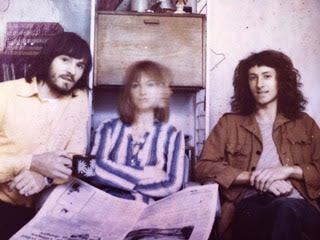
PAUL: Not really. I’m ambivalent about prog. There’s a lot of prog I don’t like, like the real flashy, clever stuff, the virtuoso stuff, you know? I like prog music that’s sort of good poetry, and interesting music that’s not overpowering.
That’s why Genesis was so good, because they had incredible music that had great lyrics as well. Prog was just accidental. I was invited to a lot of prog music festivals over the years, to be an exhibitor selling my wares and chatting with people.
ME: And that’s when you started doing your live paintings at concerts.
PAUL: Yeah. I do a painting while the band is playing. And people can watch me do it. It’s a lot of fun.
Paul: My live paintings started in Mexico at the Baja Prog festival. I went there three years in a row because it’s close to Los Angeles and I can bring stuff there. And the guy that works at the festival said, you know Paul, you exhibit here, but feel free to take part in the show. So I asked a couple of bands I knew, could I paint while you play? If it was a band I’d done the record cover for I offered to reproduce it during the show.
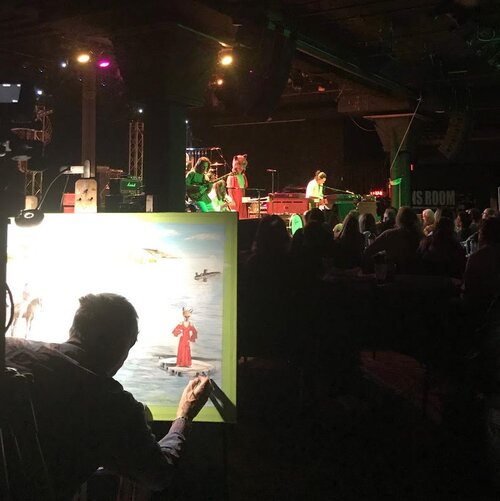
And it worked out great. You know, painting is a very solitary experience. You sit in the studio usually by yourself and you work away for hours. So for me it was a challenge, first to do something that’s taken weeks to paint in 90 minutes. So you go, okay, how am I going to do this image that took days and days and days in 90 minutes? The adrenaline really gets going because you’re painting and watching the clock.
ME: And people in the crowd are watching you while you do this.
PAUL: Oh yeah. And very often there’s a camera and what I’m painting is projected on a screen behind the band. I’ll start painting, getting into a flow, then I’ll check my watch and say, shit, I better start going a bit faster, you know? (chuckles) So then you start to paint something you’re familiar with in a new way, a faster, more immediate way. It’s still the same record cover, but it becomes an original.
ME: Have you ever not been able to finish a painting on time?
PAUL: No, because as I work I keep an eye on the time. If I have to, I’ll simplify the painting to get the same effect and get the job done.
ME: So you still do live paintings?
PAUL: Oh, yes.
ME: Aside from the occasional prog, what music do you listen to? Do you have a preference?
PAUL: I listen to anything really. My tastes are eclectic. But if I had to choose a real preference, it would be jazz. Particularly keyboards. Jimmy Smith, Jack McDuff. And modern jazz. I love to discover stuff.
ME: So how does your Borg Symphony fit into all this? As I understand, players in the group are assimilated? What’s the story with that?
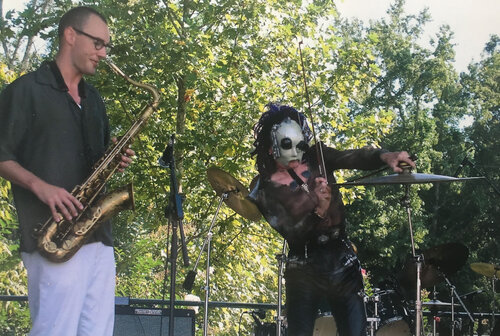
PAUL: I’ve always been interested in music. I never learned an instrument. But along the way certain bands I worked with would get new equipment and give me their old keyboard or amp. As time went by the instruments got more digital. You could do sequences, and loops, and use Pro Tools. And I’m computer savvy. So then I started putting bits and pieces of music together. And my thought originally was what kind of music would a cyborg make? A being that was half human and half computer? Because you’d have all the digital cybernetic stuff down pat, but you’d also have human emotions.
A lot of my musician friends initially went, oh God, Paul’s doing music, this is going to be awful. (chuckles) But I got together with them and we played and they said, you’re really good at this. So that’s how it evolved. It’s never the same people in the band. It’s always a different line-up.
ME: So essentially the Borg Symphony plays music that a Borg might play?
PAUL: Yeah, we use loops. We have a drum machine. We also have a real drummer, a bass player, and guitar players. My contribution is the electronic cybernetic part of it. What I play is spacey, electronic stuff. It can set the tone for the other guys or it can be the lead instrument. And nobody dominates. We all respect each other and we learn to listen to each other. We have these conversations.
ME: You mean like jazz? It’s mostly improvised?
PAUL: Well, they finish up being compositions. We’ll play and say, hey, hold a minute, that’s a song right there.
ME: So a composition will happen spontaneously?
PAUL: Yeah.
ME: And participants in the Borg Symphony dress up in Borg costume?
PAUL: Oh yeah. We have outfits and high tech masks that musicians can mix and match.
ME: Does the audience sometimes come to your shows dressed up?
PAUL: I don’t think so. Occasionally a Borg will sit in the audience before the show but we don’t know if he’s real or not. It causes a bit of concern. (chuckles)
ME: What’s one of the most memorable things that’s happened at one of your shows?
PAUL: When we had a petite 5’3″ dominatrix, in full leather gear and thigh high boots, as our Borg Queen. She was the narrator. She did a great job.
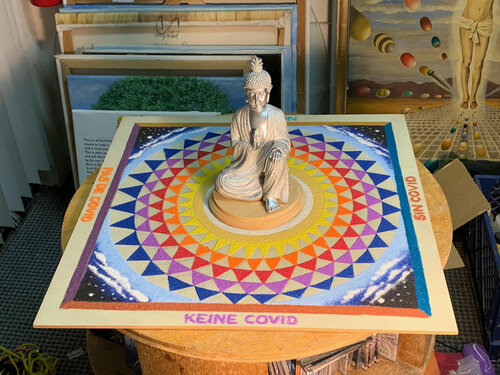
ME: Live shows have obviously taken a hit lately. How are you handling the pandemic? Do you find it constraining?
PAUL: Not really. I’m not afraid to be on my own. I mean, I work on my own. I don’t have a relationship with anybody. I was married, but no more. So being isolated wasn’t a big freak out for me. I do miss going out to see movies, or to dinner.
ME: Speaking of going out, did you ever party with any members of Genesis?
PAUL: Not really. I mean, the only guy I remember going down to the pub with was Phil (Collins). I don’t think Peter drinks.
ME: Really? I didn’t see Phil as being the partier of the bunch.
PAUL: Are you kidding me? He was the ultimate sniffler, Cocaine guy. He talks about it in his book. He was a major cokehead.
ME: Paul, thank you for taking the time to speak with me. It was a pleasure meeting you. Take care of yourself.
PAUL: Stay warm. *
ME: I’ll try.
THE END
At the time of this interview last winter, it was 13° Celsius in Ventura, California, where Paul lives, while the temperature in Montreal, where I live, was -8° Celsius.


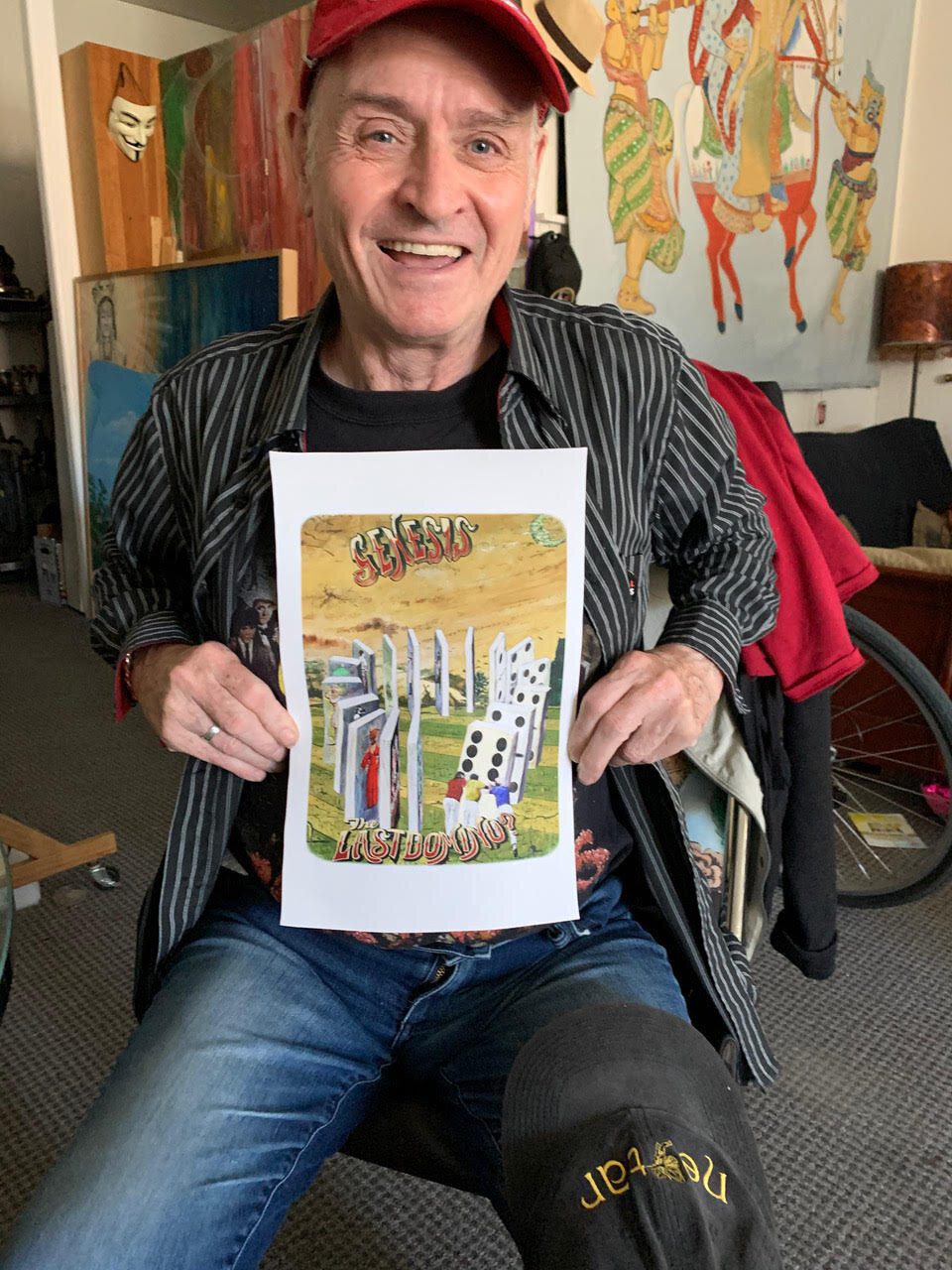







Leave a Reply